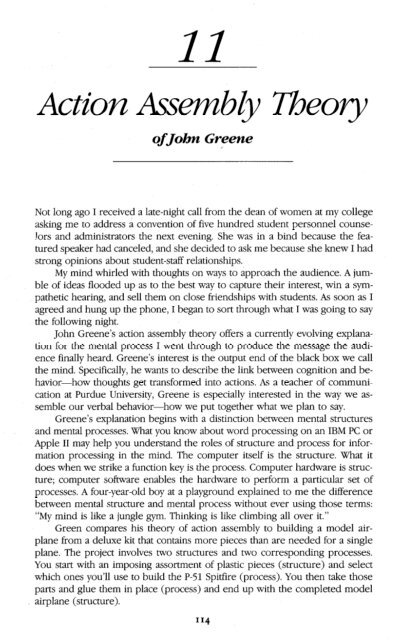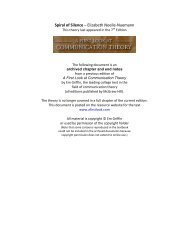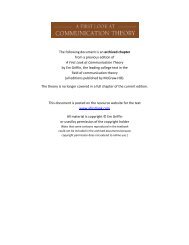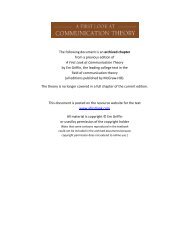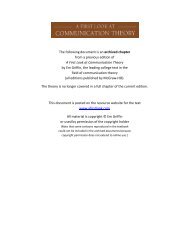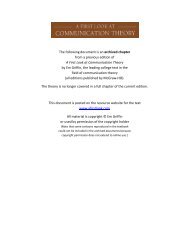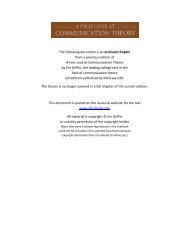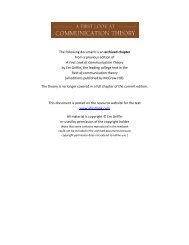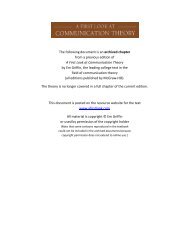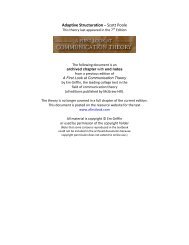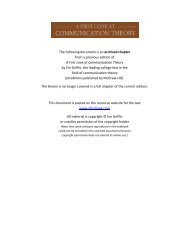Action Assembly Theory (PDF) - A First Look at Communication Theory
Action Assembly Theory (PDF) - A First Look at Communication Theory
Action Assembly Theory (PDF) - A First Look at Communication Theory
You also want an ePaper? Increase the reach of your titles
YUMPU automatically turns print PDFs into web optimized ePapers that Google loves.
<strong>Action</strong> <strong>Assembly</strong> <strong>Theory</strong><br />
of John Greene<br />
Not long ago I received a l<strong>at</strong>e-night call from the dean of women <strong>at</strong> my college<br />
asking me to address a convention of five hundred student personnel counselors<br />
and administr<strong>at</strong>ors the next evening. She was in a bind because the fe<strong>at</strong>ured<br />
speaker had canceled, and she decided to ask me because she knew I had<br />
strong opinions about student-staff rel<strong>at</strong>ionships.<br />
My mind whirled with thoughts on ways to approach the audience. A jumble<br />
of ideas flooded up as to the best way to capture their interest, win a symp<strong>at</strong>hetic<br />
hearing, and sell them on close friendships with students. As soon as I<br />
agreed and hung up the phone, I began to sort through wh<strong>at</strong> I was going to say<br />
the following night.<br />
John Greene’s action assembly theory offers a currently evolving explan<strong>at</strong>ion<br />
for the mental process I went through to produce the message the audience<br />
finally heard. Greene’s interest is the output end of the black box we call<br />
the mind. Specifically, he wants to describe the link between cognition and behavior-how<br />
thoughts get transformed into actions. As a teacher of communic<strong>at</strong>ion<br />
<strong>at</strong> Purdue University, Greene is especially interested in the way we assemble<br />
our verbal behavior-how we put together wh<strong>at</strong> we plan to say.<br />
Greene’s explan<strong>at</strong>ion begins with a distinction between mental structures<br />
and mental processes. Wh<strong>at</strong> you know about word processing on an IBM PC or<br />
Apple II may help you understand the roles of structure and process for inform<strong>at</strong>ion<br />
processing in the mind. The computer itself is the structure. Wh<strong>at</strong> it<br />
does when we strike a function key is the process. Computer hardware is structure;<br />
computer software enables the hardware to perform a particular set of<br />
processes. A four-year-old boy <strong>at</strong> a playground explained to me the difference<br />
between mental structure and mental process without ever using those terms:<br />
“My mind is like a jungle gym. Thinking is like climbing all over it.”<br />
Green compares his theory of action assembly to building a model airplane<br />
from a deluxe kit th<strong>at</strong> contains more pieces than are needed for a single<br />
plane. The project involves two structures and two corresponding processes.<br />
You start with an imposing assortment of plastic pieces (structure) and select<br />
which ones you’ll use to build the P-51 Spitfire (process). You then take those<br />
parts and glue them in place (process) and end up with the completed model<br />
airplane (structure).<br />
114


